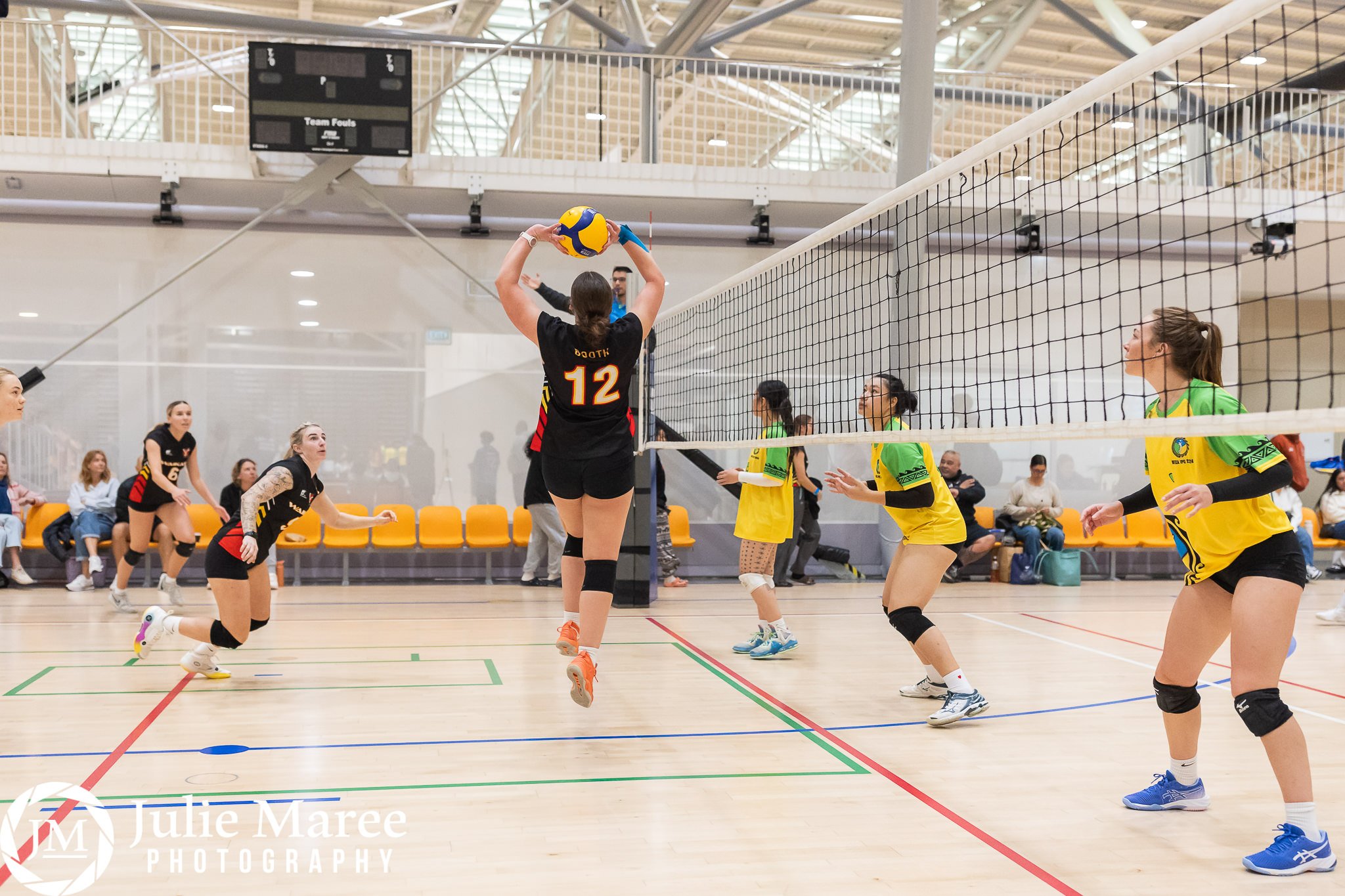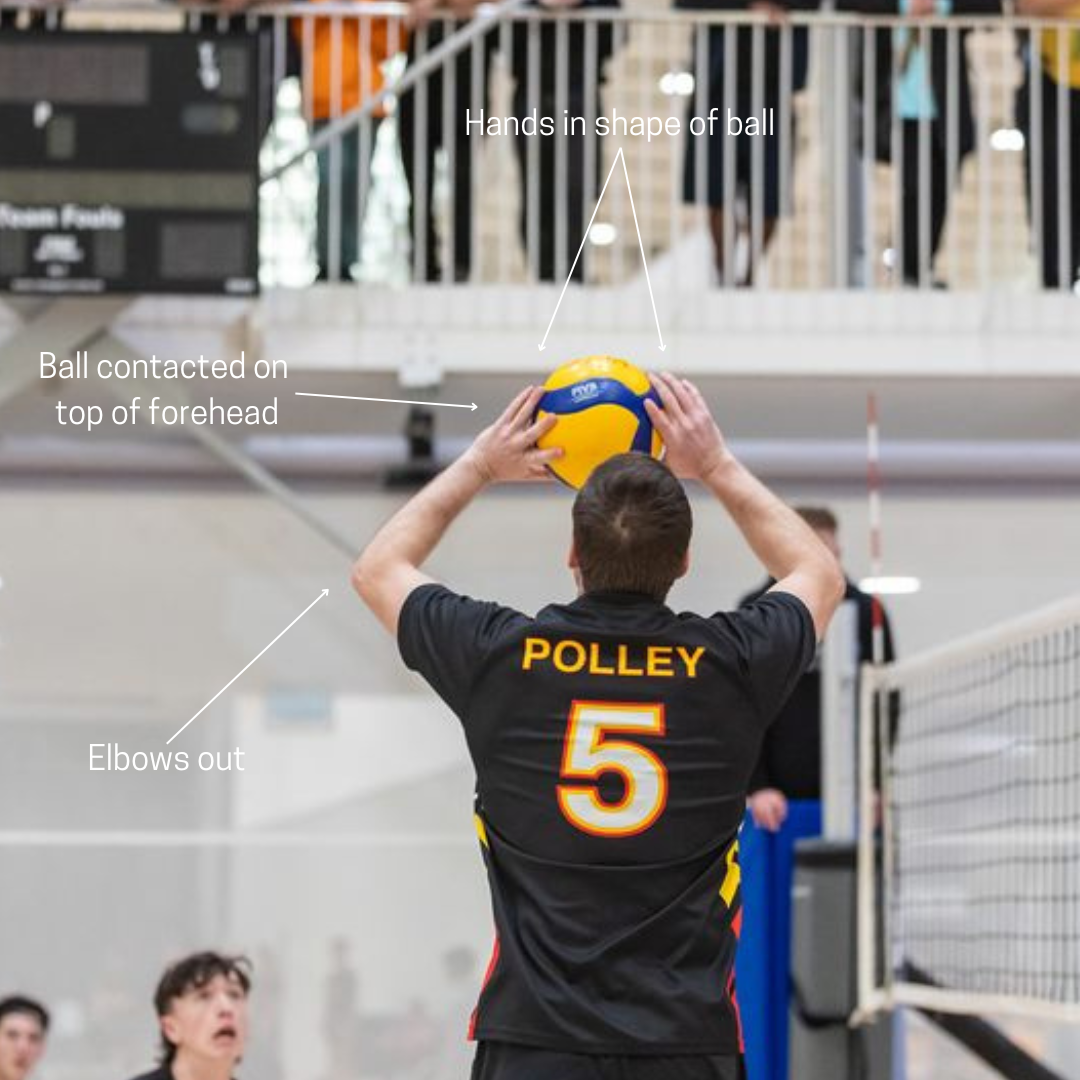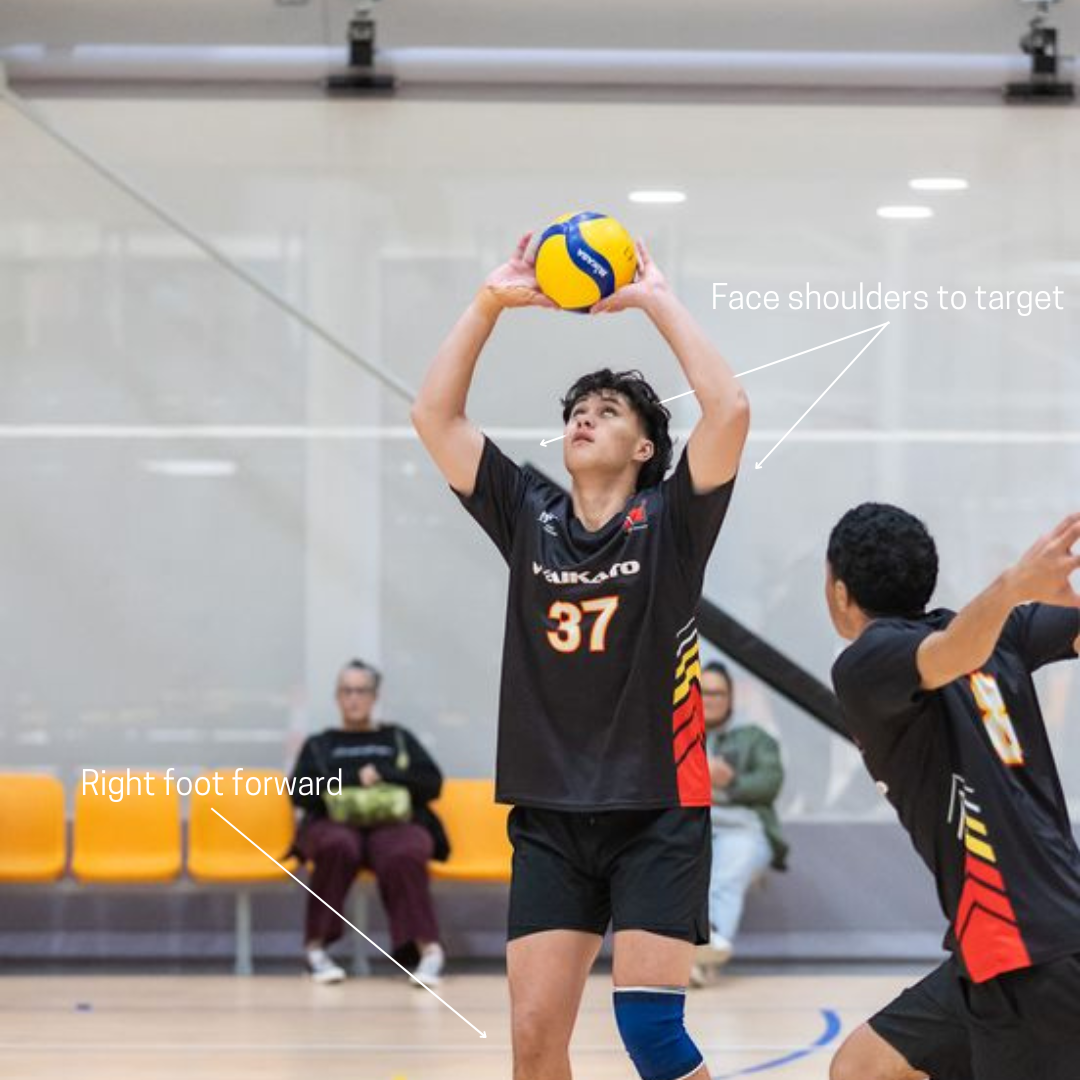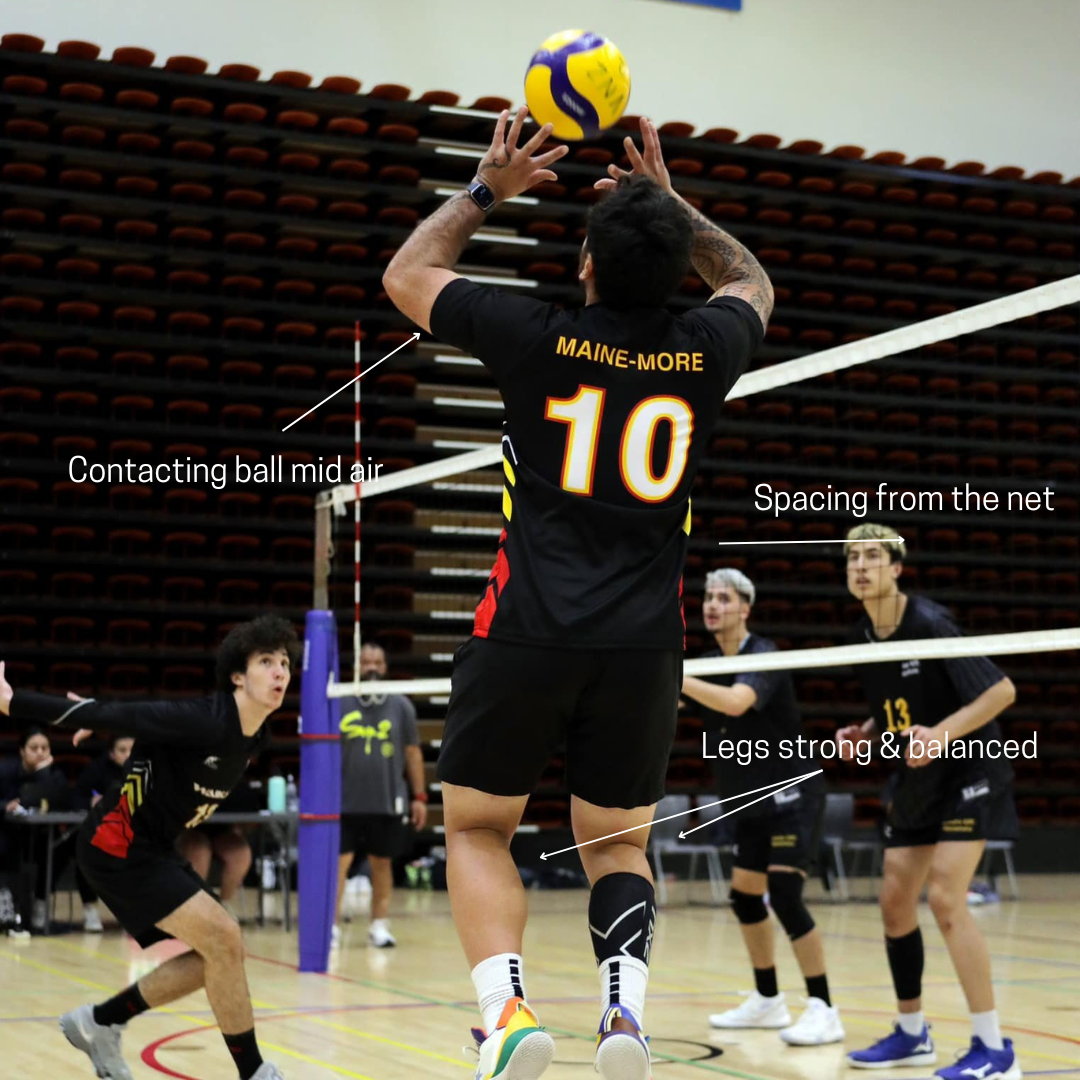
SETTING is an overhead skill used primarily to deliver the ball to an attacker in an offense, but can be used to pass the ball as well. Setting is a fundamental skill that all volleyball players need to learn how to do proficiently.
Basics of Setting
Setting is a fundamental skill that should be taught to all players, not just those in the setting position. A good set should be released cleanly from the hands. Keeping all actions simple and consistency is key when learning how to set.
-
Just like most actions in volleyball, we will most likely need to move our feet to the ball to make a set, so it is important to start in a loaded/ready position.
Start with your right foot forward and left foot slightly back to form a strong stable base. Bend at the knees and both hands in front ready to move.
When moving to the ball, take big efficient steps. Try to beat the ball and be ready to set, rather than just getting there on time.
You always want to be stopped before setting and be in your athletic position with your right foot slightly forward and left foot slightly back to form that balanced base.
-
It is important that we have have soft buttery fingers when setting. In simple terms, setting is about catching and throwing in one really quick motion.
Hand Positioning
Raise your hands above your forehead with your fingers spread wide. Your thumbs should form a triangle, and your wrists should be firm.
Your elbows should be bent and wide outside of your bodyline (pictured above).
Remember to relax the fingers as setting is a delicate contact, not hitting the ball with a hard surface.
-
Contact
As the ball approaches, contact it with your fingertips, pushing it upward. Your arms should extend fully during the set.
Set Direction
Direct the ball toward your target whether that is to a hitter or to a specific target.
Follow Through
After releasing the ball, let your hands follow through, keeping your body facing the target to maintain balance. Don’t flick your fingers and this can affect the location of the set.
Advanced Setting
Mastering the advanced setting techniques enables setters to be dynamic and unpredictable playmakers. Executing the jump set, back set and pivot step requires efficient and precise footwork and timing.
-
Jump setting adds an element of of dynamism to your setting.
Preparation
Start in a good base position with your feet shoulder-width apart and knees slightly bent. Face the court so you can have better vision of where the pass is coming from.
Rhythm Step
As the ball is passed, move to the ball using big efficient steps. As you set the ball, finish with a Left-Right-Jump step.
Timing
Jump just before you reach the ball. You want to time your jump so you’re at your peak when you make contact with the ball.
Hand Position
Raise your hands above your head with your fingers spread wide. Your thumbs should form a triangle, creating a solid platform for the ball.
Contact
As you reach the peak of your jump, make contact with the ball using your fingertips. Focus on pushing the ball upward and slightly forward toward your hitter.
Follow Through
The follow through after the set is important as it can affect the location of the ball. Finish with a ‘Hi 10’ (don’t flick your fingers) and face your body to the target.
-
Being able to back set is an important skill in volleyball, especially for setters setting in an offense.
Your preparation, movement, jump and timing are the same as above (in the jump setting section).
Back Setting
While you’re setting, take the ball more on top of your head and lean slightly back to help guide the ball behind you. Your body should remain balanced and stable throughout the motion.
Remember to not arch too much as your set will go to the ground rather than up high.
Remember also that your body placement will determine where the ball goes behind you (as you can’t see). Practise this to see what works for you.
-
The pivot step is usually used in out of system situations where you have to run off the net. We use this as it allows us last minute adjustment to get square to the target.
Get feet to the ball then use the right foot to pivot to square to target. Use the left foot to drive through the pivot.
Hands need to be in contact with ball after the pivot, not before. Contacting the ball before pivoting means you will most likely catch and throw the ball.
Setting an Offense
Setting an effective offense requires the setter to distribute the ball among the outsides, opposites and middle hitters. Each position has unique set, and setters must execute these to maximise hitting opportunities.
-
The Outside Hitter statistically receives the most sets and is the go to attacker, especially in out of system plays. The set to the outside depends on the play, set faster when they are in position or higher when not to give them more time to get their feet to the ball.
Standard Set
A standard set gives the outside hitter time to get into position, assess the block, and adjust their approach. It’s reliable but slower, usually used at the school level. The set should be about 1-2m above the antenna and hitters need to wait for the set to release on their approach.
Go Ball
This is a fast and lower set that aims to beat the opponent’s offense with speed. Hitters need to be on their 2nd step of their approach when the setter contacts the ball.
Back Row Set
This set allows the backcourt outside to be an attacking option. The set should be on or slightly in front of the 3m line. The tempo or height & speed of the set will depend on the level of play.
Out of System
This set is typically really high. We use this on broken plays as to give the hitter more time to get their feet to the ball and assess the block and defense. Set the ball high (to give time to approach), off the net (to allow space for the hitter to attack) and slightly inside (to allow a bigger hitting window).
-
The Opposite Hitter hits from the right side or Position 2. Setting the Opposite will require a back set as setters will always try and face the outside.
Standard Back Set
Similar to a high outside set but aimed to the right side, this set is slower and gives the opposite hitter time to approach and execute their attack. The set should be 1-2m above the antenna.
Red (fast tempo set)
A quick, low set to the right side aimed at catching the blockers off-guard by moving the attack to the right side at a fast tempo. The height of the set should be slightly above or at the height of the antenna.
3D (backcourt set)
This set is used when the opposite hitter rotates to the back row but can still attack from behind the 3m line. The tempo of the set depends on the level of play. Aim the set to be on or slightly in front of the 3m line.
Out of System
The Opposite Hitter is usually 1 of 2 front hitting options in Out of System situations. Set the ball high (to give time to approach), off the net (to allow space for the hitter to attack) and slightly inside (to allow a bigger hitting window).
-
Middle sets are very quick and very dynamic. The middle hitter is usually the most explosive option on the court, attacking close to the setter. They excel at quick sets that speed up the offense and put pressure on the blockers.
A Quick or Quick 1
A fast, low set placed directly in front of the setter, usually about a foot above the net. The middle hitter attacks almost immediately, aiming to catch the blockers off guard.
C or Back 1
The same tempo as an A Quick but behind the setter.
A Dead
A high set in front of the setter. This set is about 2m high and gives middles time to get get their feet to the ball.
Slide
This set is fast and dynamic. Set the ball behind to the right side where the middle run and attack using a one-footed take off.
Setting Principles
-
A good set should have minimal spin (clean release), height and accuracy. If setting to a hitter, we want the ball to be ‘hittable’. Keeping your actions simple is important when setting.
-
Setting is not just for setters, all players need to be able to do this fundamental proficiently. During out of system situations, all players need to be prepared to deliver a hittable ball to the hitters.
-
Always move to be directly underneath the ball to ensure a clean set and use big efficient steps to get to the ball. Keep your feet shoulder-width apart and knees slightly bent with your right feet slightly forward and left foot slightly back for stability.
-
Sets to the Outside Hitter includes a standard set, a go ball (fast set), high ball set (used in out of system), a B set (slightly inside) and a Pipe set from the back court (can be a positive or negative set).
-
Sets to the Opposite usually requires a back set as setters always want to face forward to the left pin. Sets to the Opposite include the standard back set, a red (fast ball tempo) and 3D (backrow option).
-
There is a wide variety of middle sets that can be quick and dynamic. These include A Quick or Quick 1, C or Back 1, Shoot, A Dead and Slide.
-
Learning how to deliver a hittable ball to your hitters in out of system situations is important. The majority of the game is off bad passing, so learning how to play with that will help.
-
When there’s a bad pass (out of system), set the ball high (to give time to approach), off the net (to allow space for the hitter to attack) and slightly inside (to allow a bigger hitting window). We want the ball to be ‘hittable’.



